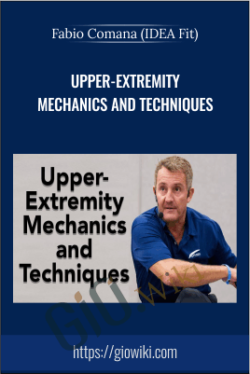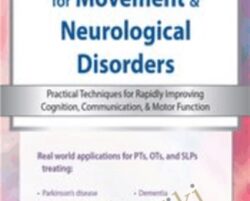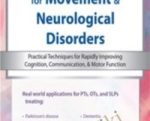There’s no greater triumph than seeing your patients regain their functional independence, especially when you’ve played a pivotal role in their progress.But when you’re working with patients who are older or affected by movement/neurological disorders, neuromotor deficits often impede progress, interfering with functional multitasks, such as walking while talking, that combine cognition, communication, and motor function.This can drag therapy to a crawl, limit your clinical effectiveness, and cause a variety of setbacks, including:FallsCommunication deficitsPoor executive functionMemory/attention issuesTask avoidanceDifficulty performing ADLsFunctional codependenceGait and balance problemsAnxiety, frustration and depressionApathy and isolationWithout intervention, these patients often become resigned to living life in slow motion, limited to basic tasks and always feeling a step behind in their work, home and community. But with the latest advances in dual-task training, you can change this.Let Physiotherapist Josefa Domingos and Speech-Language Pathologist John Dean be your guides to success as they walk you through practical applications of dual-task training for your patients.Learn how to unmask deficits that are secretly plaguing progress, integrate dual-task interventions into both therapy and daily life, and rapidly improve performance of functional activities between therapy sessions.Purchase now, and discover your patients’ joy and gratitude when you show them how much more they can accomplish, using the fun, engaging framework for dual-task training you’ll learn in this hands-on recording.Explain the latest advances in dual-task training and their implications for your patients.Demonstrate a comprehensive assessment, identifying and differentiating causes of disability and impairment.Integrate dual-task exercises into interventions to improve performance in functional daily life activities.Combine multiple approaches for better outcomes, including dual-task training, voice and communication therapies, cognitive activities, ADL training, exercise, and amplitude-based approaches.Evaluate real-world applications for a wide range of movement and neurological disorders.Apply the assessments and interventions discussed in this seminar to a series of interactive case studies. Hot Topics and InnovationsCurrent concepts of dual-task trainingCutting edge clinical and research applicationsRapidly evolving tech landscapeAppsSmart speakersWearablesConfidently Identify the Underlying Cause of ImpairmentLearn a comprehensive framework for assessing:Interference of cognition in movementGait problemsFalls and balanceCognitive problemsMemoryAttentionExecutive functionCommunication deficitsDifficulties with daily activitiesDressing and bathingCleaning and cookingTechnology (e.g. computer, phone)Transfer issuesFatigue, anxiety and depressionHands-on LabUpgrade Your Rehab Toolbox With the Latest Dual-Task Training MethodsCutting-edge techniques to:Increase dual-task performance in daily life activitiesBoost cognition, communication, and social interactionChallenge, motivate and engage patientsEnhance gait speed, rhythm, and stride lengthPrevent falls and improve balanceEnhance carryover outside of the treatment roomImprove postureRestore functional independenceReduce load and stress on caretakersHands-on LabCombine Multiple Approaches for Better OutcomesSynergistic strategies for effectively integrating:Dual-task trainingVoice and communication therapiesCognitive activitiesADL trainingAmplitude-based approachesExercise-based interventionsDanceBoxingHydrogymnastics/hydrotherapyPole walkingBalance trainingHands-on LabReal World Applications for Common Diagnoses and ConditionsParkinson’s diseaseProgressive supranuclear palsyMultiple system atrophyCorticobasal ganglionic degenerationHuntington’s diseaseStrokeBrain injuryDementiaMild cognitive changes related to:MedicationsPrevious injuries“Chemo brain”Indications, contraindications, and limitations of researchHands-on LabImprovise Solutions Using Your New Dual-Task Training SkillsCase study: Correctly identify the underlying causes of impairment when the patient’s deficits do not readily appear on standardized assessmentsCase study: Use dual-task training to replicate daily activities and improve carryover in the home environmentCase study: Incorporate everyday tech into practice, using apps and online resourcesCase study: Develop a transdisciplinary treatment plan for a patient with Parkinson’sCase study: Overcome barriers to effective strategy implementationHot Topics and InnovationsCurrent concepts of dual-task trainingCutting edge clinical and research applicationsRapidly evolving tech landscapeAppsSmart speakersWearablesConfidently Identify the Underlying Cause of ImpairmentLearn a comprehensive framework for assessing:Interference of cognition in movementGait problemsFalls and balanceCognitive problemsMemoryAttentionExecutive functionCommunication deficitsDifficulties with daily activitiesDressing and bathingCleaning and cookingTechnology (e.g. computer, phone)Transfer issuesFatigue, anxiety and depressionHands-on LabUpgrade Your Rehab Toolbox With the Latest Dual-Task Training MethodsCutting-edge techniques to:Increase dual-task performance in daily life activitiesBoost cognition, communication, and social interactionChallenge, motivate and engage patientsEnhance gait speed, rhythm, and stride lengthPrevent falls and improve balanceEnhance carryover outside of the treatment roomImprove postureRestore functional independenceReduce load and stress on caretakersHands-on LabCombine Multiple Approaches for Better OutcomesSynergistic strategies for effectively integrating:Dual-task trainingVoice and communication therapiesCognitive activitiesADL trainingAmplitude-based approachesExercise-based interventionsDanceBoxingHydrogymnastics/hydrotherapyPole walkingBalance trainingHands-on LabReal World Applications for Common Diagnoses and ConditionsParkinson’s diseaseProgressive supranuclear palsyMultiple system atrophyCorticobasal ganglionic degenerationHuntington’s diseaseStrokeBrain injuryDementiaMild cognitive changes related to:MedicationsPrevious injuries“Chemo brain”Indications, contraindications, and limitations of researchHands-on LabImprovise Solutions Using Your New Dual-Task Training SkillsCase study: Correctly identify the underlying causes of impairment when the patient’s deficits do not readily appear on standardized assessmentsCase study: Use dual-task training to replicate daily activities and improve carryover in the home environmentCase study: Incorporate everyday tech into practice, using apps and online resourcesCase study: Develop a transdisciplinary treatment plan for a patient with Parkinson’sCase study: Overcome barriers to effective strategy implementationHot Topics and InnovationsCurrent concepts of dual-task trainingCutting edge clinical and research applicationsRapidly evolving tech landscapeAppsSmart speakersWearablesConfidently Identify the Underlying Cause of ImpairmentLearn a comprehensive framework for assessing:Interference of cognition in movementGait problemsFalls and balanceCognitive problemsMemoryAttentionExecutive functionCommunication deficitsDifficulties with daily activitiesDressing and bathingCleaning and cookingTechnology (e.g. computer, phone)Transfer issuesFatigue, anxiety and depressionHands-on LabUpgrade Your Rehab Toolbox With the Latest Dual-Task Training MethodsCutting-edge techniques to:Increase dual-task performance in daily life activitiesBoost cognition, communication, and social interactionChallenge, motivate and engage patientsEnhance gait speed, rhythm, and stride lengthPrevent falls and improve balanceEnhance carryover outside of the treatment roomImprove postureRestore functional independenceReduce load and stress on caretakersHands-on LabCombine Multiple Approaches for Better OutcomesSynergistic strategies for effectively integrating:Dual-task trainingVoice and communication therapiesCognitive activitiesADL trainingAmplitude-based approachesExercise-based interventionsDanceBoxingHydrogymnastics/hydrotherapyPole walkingBalance trainingHands-on LabReal World Applications for Common Diagnoses and ConditionsParkinson’s diseaseProgressive supranuclear palsyMultiple system atrophyCorticobasal ganglionic degenerationHuntington’s diseaseStrokeBrain injuryDementiaMild cognitive changes related to:MedicationsPrevious injuries“Chemo brain”Indications, contraindications, and limitations of researchHands-on LabImprovise Solutions Using Your New Dual-Task Training SkillsCase study: Correctly identify the underlying causes of impairment when the patient’s deficits do not readily appear on standardized assessmentsCase study: Use dual-task training to replicate daily activities and improve carryover in the home environmentCase study: Incorporate everyday tech into practice, using apps and online resourcesCase study: Develop a transdisciplinary treatment plan for a patient with Parkinson’sCase study: Overcome barriers to effective strategy implementationGet Dual Task Training for Neurological Disorders …- John Dean & Josefa Domingos, Only Price $39Tag: Dual Task Training for Neurological Disorders …- John Dean & Josefa Domingos Review. Dual Task Training for Neurological Disorders …- John Dean & Josefa Domingos download. Dual Task Training for Neurological Disorders …- John Dean & Josefa Domingos discount.
 Introduction to Nei Gong & Engagement Qualities – Sam F.S. Chin
₹2,158.00
Introduction to Nei Gong & Engagement Qualities – Sam F.S. Chin
₹2,158.00
 (IDEA Fit) – Upper-Extremity Mechanics and Techniques – Fabio Comana
₹4,316.00
(IDEA Fit) – Upper-Extremity Mechanics and Techniques – Fabio Comana
₹4,316.00
Dual Task Training for Neurological Disorders: Practical Techniques for Rapidly Improving Cognition, Communication & Motor Function – John Dean & Josefa Domingos
₹5,810.00




